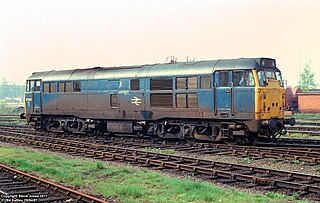
The British Rail Class 31 diesel locomotives, also known as the Brush Type 2 and previously as Class 30, were built by Brush Traction from 1957 to 1962. They were numbered in two series, D5500-D5699 and D5800-D5862. Construction of the first locomotive was completed in the final week of September 1957, and the handing-over took place on 31 October. The first Class 31 entered service in November 1957, after the launch of the Class 20 locomotive and was one of the Pilot Scheme locomotives ordered by British Railways to replace steam traction.
A wide variety of steam locomotives have been used on Ireland's railways. This page lists most if not all those that have been used in the Republic of Ireland and Northern Ireland. Irish railways generally followed British practice in locomotive design.
Schull and Skibbereen Railway 4Erin was a 4-4-0T locomotive manufactured by Nasmyth, Wilson and Company of Patricroft near Manchester in 1888. It was the Schull and Skibbereen Railway's fourth locomotive.
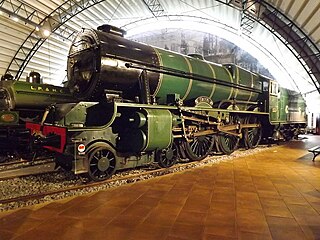
The Great Southern Railways Class 800 steam locomotives were built principally for express passenger work on the Dublin to Cork main line of that company. These locomotives were designed under the supervision of E. C. Bredin with his Chief Draughtsman, H. J. A. Beaumont, preparing the drawings. They were the largest and most powerful engines ever to run in Ireland by quite a large margin, and the only three express passenger locomotives to be built in an independent Ireland.
The Furness Railway Company owned many different types of locomotives, built by several locomotive building companies, including Sharp, Stewart and Company. Others were built by the Furness' constituent companies - the Whitehaven and Furness Junction Railway, among others.
Tralee and Dingle Light Railway 7 and 8 were two 2-6-0T locomotives manufactured by Kerr, Stuart and Company in 1902 and 1903 for the Tralee and Dingle Light Railway.

The GS&WR Class 101, classified as Class 101 or Class J15 by the Great Southern Railways, was a class of 0-6-0 steam locomotives designed for working goods traffic although they did, and were quite capable of, working branch and secondary passenger trains.
The DD class (later reclassified into D1, D2 and D3 subclasses) was a passenger and mixed traffic steam locomotive that ran on Victorian Railways from 1902 to 1974. Originally introduced on mainline express passenger services, they were quickly superseded by the much larger A2 class and were relegated to secondary and branch line passenger and goods service, where they gave excellent service for the next fifty years. The DD design was adapted into a 4-6-2T tank locomotive for suburban passenger use, the DDE (later D4) class. They were the most numerous locomotive class on the VR, with a total of 261 DD and 58 locomotives built.

The North Eastern Railway Class M1 is a class of 4-4-0 steam locomotive, designed by Wilson Worsdell. 20 initial engines were built, then 30 further units were built, designated Class Q.
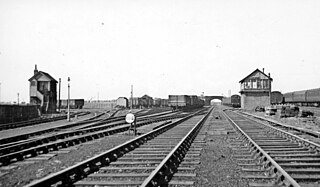
The Cleator and Workington Junction Railway (C&WJR) was located in West Cumberland in Northern England, serving the towns of Cleator Moor and Workington and intermediate villages. It was mainly used for coal, limestone and iron ore traffic for the local industries.

The Schull and Skibbereen Railway was a minor narrow gauge railway in County Cork, Ireland. It opened in 1886 and closed in 1947. The track gauge was a 3 ft narrow gauge. The formal name of the company was The West Carberry Tramways and Light Railways Company Ltd.
The Prussian Class G 5.1 steam engines were the first 2-6-0 goods locomotives in Europe. They were developed for the Prussian state railways from the Class G 4 and a total of no less than 264 units of this class were placed in service in Prussia between 1892 and 1902. The twin-cylinder G 5.1 had been designed to raise the speed of goods trains on main lines. In addition, more powerful engines were needed for the increasingly heavy train loads. The locomotives, which were equipped with a compressed air brake, were used in charge of fast goods trains (Eilgüterzugdienst) and also passenger trains due to their impressive top speed of 65 km/h. The G 5.1 was fitted with inside Allan valve gear and the carrying wheels were of the Adams axle design. The engines were coupled with tenders of Class pr 3 T 12. In Prussian service they were renumbered in 1905 into the 4001–4150 range.
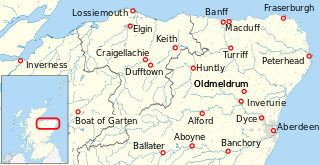
The locomotives of the Great North of Scotland Railway were used by the Great North of Scotland Railway to operate its lines in the far north-east of the country. The railway opened in 1854 with just five 2-4-0 steam locomotives, and from 1862 it used 4-4-0 exclusively as the wheel arrangement for its tender locomotives. When it expanded by amalgamation in 1866, it inherited some locomotives from these companies. It purchased most of its locomotives, although building a small number itself, two at its first works at Kittybrewster, and ten later at Inverurie Locomotive Works.
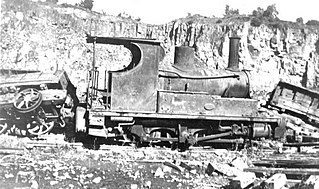
The WAGR S class was a two-member class of 0-6-0WT tank locomotives operated by the Great Southern Railway (GSR) and later Western Australian Government Railways (WAGR).

The E.17 class was a class of patent long boiler steam locomotive built by the Robert Stephenson & Company for the New South Wales Government Railways of Australia.

The Port Elizabeth Harbour 0-4-0ST of 1894 was a South African steam locomotive from the pre-Union era in the Cape of Good Hope.

The LNWR 4ft 6in Tank was a class of 220 passenger 2-4-2T locomotives manufactured by the London and North Western Railway in their Crewe Works between 1879 and 1898. The "4ft 6in" in the title referred to the diameter of the driving wheels – although the stated dimension was for the wheel centres – the nominal diameter including the tyres was 4 ft 8+1⁄2 in (1,435 mm).

The MGWR Class L/Lm/Ln were Midland Great Western Railway (MGWR) 0-6-0 locomotives. Following merger of the MGWR into the Great Southern Railways (GSR) in 1925 these locomotives still generally kept to their former area, as did the equivalent GS&WR Class 101 standard goods to their former area. Whereas Class 101 was noted for some working of branch line passenger trains this was less likely for the MGWR class L; however they were noted for passenger mixed working on the Clifden and Ballaghaderreen branch lines.
The Great Southern Railways (GSR) Class 495 consisted of a single 0-4-0ST built by Peckett and Sons and originally supplied to Allman & Co., Distillers of Bandon, County Cork in 1920. It was purchased in 1930 by the GSR for use on Victoria Quays section of the Cork City Railways where it had the ability to negotiate tight curves and was the only locomotive permitted to work the sharp curves to Anderson's Quay. From the mid 1930s it appears to have been used only intermittently and was withdrawn in 1949.
Dublin, Wicklow and Wexford Railway (DW&WR) 11 built in 1896 was the predecessor to a total of twelve 2-4-2T locomotives to emerge from Grand Canal Street railway works between 1896 and 1910. Eleven of twelve lasted through to the early 1950s, the only loss being due to the Civil war, and despite attempts to replace them remained they remained vital to the running of the South Dublin services suburban services to Bray throughout their lives.













